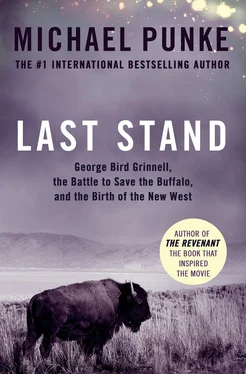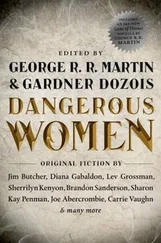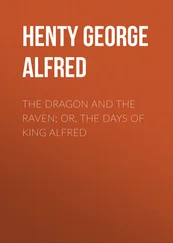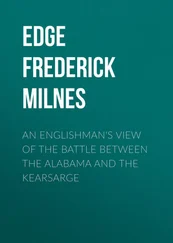The following autumn, no doubt at the intervention of his parents, Grinnell was set up with a new tutor, a physician named Dr. Hurlburt, this time in Stamford. Dr. Hurlburt, according to Grinnell, was “not only a good tutor, but a good handler of boys.” His prescription for the wayward Grinnell: a “course of sprouts.” Hurlburt roused Grinnell at an early hour, taking him along on his rounds. As they drove along in his buggy, Grinnell recited his lessons, then studied on his own while the doctor made house calls. At the end of two semesters, Grinnell returned again to Yale, this time passing his exams “with flying colors.” 17
Though back on track, Grinnell evinced no particular interest in where that track might lead. Inertia seemed to be the main force to compel him, and inertia seemed to be leading him toward a rather unremarkable life as a member of an upper-class, East Coast family. The summer before his senior year, his mother took him and two brothers on a three-month tour of Europe. The Continent appeared to make no particular impression; in his memoirs he recounted no detail of the trip beyond a list of the countries visited. On returning to Yale for his senior year, Grinnell was elected—in good Yale fashion—to Scroll and Key, a secret society. He offered no hint of what he might want to do after graduation, though he did describe himself as being “in great fear lest my degree should be withheld on account of my poor scholarship.” Beyond this concern, his descriptions of his last year in college are bland: “I roomed in the old south college, and the room faced the green.” 18
Opportunity, though, was on the horizon—opportunity that would extend Grinnell’s horizons far beyond the south college green.
IN THE SPRING OF 1870, A FEW MONTHS BEFORE GEORGE BIRD GRINNELL would graduate from Yale, a rumor swept the campus. A professor named Othniel Charles Marsh, it was reported, intended that summer to lead a scientific expedition to the far west. The expedition was to be manned by a dozen recent Yale graduates with the purpose of searching for dinosaur bones. 19
For perhaps the first time in his life, Grinnell felt the spark of genuine inspiration. “This rumor greatly interested me,” he remembered, “for I had been brought up, so to speak, on the writings of Captain Mayne Reid.” Captain Reid, in fact, might almost have been speaking for Grinnell when he wrote in his novel Wild Life that “I as well as others yearned for the life beyond the confines of our secluded valley, and sighed for a participation in those deeds of which now and then a rumor reached our ever-attentive ears.” Grinnell had long harbored the desire to visit the western scenes described by Reid and Audubon “but had supposed they were beyond my reach.” Now, suddenly, an opportunity stood within range. “I determined that I must try.”
It took several days for Grinnell to summon the courage to present himself before the intimidating Professor Marsh, who looked a bit like Ulysses S. Grant, the man then president. When Grinnell finally interviewed, the professor discouraged him, promising only to inquire about the young man’s credentials. Grinnell, painfully aware of his record at Yale, could hardly have been optimistic. But when Grinnell went back for a second interview, he learned that he had been accepted as a member of the Marsh expedition.
For the first time, George Bird Grinnell was aiming in a direction that he himself had set—west. In a matter of weeks, Grinnell would depart on a five-month, 6,000-mile journey that would change the course of his life.
PROFESSOR OTHNIEL CHARLES MARSH WAS ABOUT TO EMERGE AS one of the most important scientists of his day. He was the nephew of George Peabody, a wealthy investment banker and a man considered by some to be the father of modern philanthropy. Today, museums throughout the Northeast still carry his name. Peabody was generous to Marsh too, having supported his education, first at Andover, then Yale, then in Europe. Marsh proved a brilliant student, discovering two important reptile fossils while still in college. 20
During his time in Europe, Marsh convinced his uncle to give money for the establishment of a new natural history museum at Yale as well as an endowed chair in paleontology—the first in the United States. In 1866, Marsh returned to New Haven to occupy the endowed chair and to manage the museum. Two years later, Marsh made the discovery that set the stage for Grinnell’s first great adventure.
In 1868, while traveling in the West, Marsh read an intriguing story in an Omaha newspaper. According to the report, a railroad construction worker had unearthed ancient bones while digging a well. They were, declared the paper, from the skeleton of an ancient man. Marsh was determined to investigate and managed to convince a train conductor to make an unscheduled stop at the site, a remote location known as Antelope Station. While the train cooled its engine, Marsh sifted through the mound of dirt beside the well. “I soon found many fragments and a number of entire bones, not of a man, but of horses diminutive indeed, but true equine ancestors.” He had discovered Protohippus , a three-toed, miniature horse. “I could only wonder,” he later wrote, “if such scientific truths as I had now obtained were concealed in a single well, what untold treasures must there be in the whole Rocky Mountain region?” 21
Marsh intended to find out. He had attempted to line up an expedition for 1869, but intense Indian fighting prevented it. Finally, in the summer of 1870, the way was clear.
ADVENTURE FOUND GRINNELL ALMOST IMMEDIATELY AFTER THE arrival of the Marsh expedition at Fort McPherson, Nebraska, sixteen miles east from the confluence of the north and south forks of the Platte. Professor Marsh, through a personal relationship with General Philip H. Sheridan, had arranged for close cooperation on the part of the U.S. Army. The expedition visited the fort to rendezvous with its cavalry accompaniment before heading into the field.
On the day the Marsh expedition arrived at the outpost, a dozen Sioux Indians attacked a party of antelope hunters near the fort. One young Sioux warrior galloped up close before loosing an arrow, striking one of the hunters in the arm. The hunter in turn shot the Sioux, though the wounded Indian managed to ride off. Back at Fort McPherson, a troop of cavalry was dispatched to give chase. The soldiers took with them the post scout, William F. Cody, better known as Buffalo Bill. The troops failed to find the attackers with the exception of the boy who had been shot. He was found dead, wrapped in a buffalo robe on the top of a hill. Cody carried back the boy’s moccasins and a few trinkets taken from the body. Grinnell remembered how “the newcomers from New Haven stared in wonder.” 22
Buffalo Bill himself, whom a breathless Grinnell described in his journal as “the most celebrated prairie man alive,” led the Marsh expedition on its first day out of the fort. Professor Marsh had selected as their destination the Loup River, a desolate region of low, sandy hills in the heart of Sioux territory. The cavalrymen protecting the expedition were commanded by Major Frank North, an officer with a national reputation as a famous Indian fighter. Two Pawnee—bitter enemies of the Sioux and the Cheyenne—scouted ahead of the column, sometimes crawling on their bellies through the grass to peer over hilltops before advancing. Grinnell and the other civilians rode on Indian ponies, captured from the Cheyenne at the Battle of Summit Springs. Six army wagons brought up the rear with food, ammunition, and tents. 23
On their first night in the field, Professor Marsh delivered a campfire talk to an assembly that included Cody and most of the cavalrymen. For his topic, Marsh selected … geology. The lecture, like the broader purpose of the Marsh expedition, “greatly puzzled our military companions of the rank and file.” Nevertheless, Marsh attempted to enlighten them with explanations of various rock formations, how they had come to be formed, and the discoveries of ancient beasts that he hoped lay ahead. Buffalo Bill, though described by Grinnell as an “interested auditor,” remained among the skeptics, remarking afterward that “the professor told the boys some mighty tough yarns today.” 24
Читать дальше












